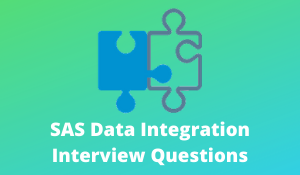
What is Data Integration?
The process of combining data from different resources.
The combined data is provided to the users with unified view.
Information from different enterprise domains are integrated – known as Enterprise Information Integration.
Useful for merging information from different technologies among enterprises.
The sub areas of data integration are
Data Warehousing.
Data Migration.
Master Data Management.
What is data dimension?
It is the definition of the customer, product and organization data to be held in central location and to be accessed by all the with governance around change. Common set of dimension are required to support all business views of data and self service reporting. Business view has the capability to segment customer, product and organization data across any dimension.
Name the scheduler for scheduling job and explain the scheduler.
The scheduler used for scheduling job is control m while CONTROL-m also user to view process flow and dependencies so that they can optimize business processes easily and efficiently, even in a data center that includes multiple platform types.
What is data access?
It is the access by selected business users to raw(untransformed) data loads.
Describe the interaction table in SAS DI.
Table that describes the relationships between two or more tables. For example, an intersection table could describe the many-to-many relationships between a table of users and a table of groups.
What do you mean by data staging area?
Staging area of the data warehouse is both the storage area and set of process commonly referred as extract transformation load. The data staging area is everything between the operational source systems and the data presentation area.
What is data governance?
It is the robust, reliable, repeatable and controlled process both at point of input and through subsequent downstream control checks. This process exists to manage updates of business rules to maintain a level of consistency.
What do you mean by fact table in dw ?
Fact table represents the subject oriented and the focus of analysis. it generally contains elements f analysis such as sales, cost, quantity sold etc. these attributes can be summed up or averaged in order to understand the particular aspects. Fact table can also be sum up as union of the dimension tables that allows the fact measures to be analyzed from different scenarios.
What is data reconciliation?
It Is the correction of the data inconsistency If data is loaded incorrectly from source system and if there is inconsistency between source system and loaded data then source system is treated authoritative.
What is operational data and operational system?
Operational data is used as source data for a data warehouse. While operational system is one or more programs that provide source data for a data warehouse.
What do you mean by exception reporting?
It is the reporting for data load completion to include any data issues.
What is the use of SAS management console?
This application provides a single user interface for performing SAS administrative tasks.
What is multi dimensional reporting?
It allows users to efficiently aggregate and analyze business metrics across core business dimensions.
What is History Preserving?
History Preserving is for providing new row in the target instead of updating the existing row.
The columns are indicated for transforming the changes that are to be preserved.
New rows are created when the value of certain column changes.
Each of these rows is flagged as UPDATE.
The UPDATE flag is applied for the input data set.
What is snow flake schema?
Snow flake schema is defined in which a single fact table is connected to multiple dimension tables. The dimension are structured to minimize update anomalies and to address single themes.
Describe deployment of SAS Data Integration studio jobs as a SAS stored process.
Job can be deploy as a SAS stored process in SAS Data Integration Studio. Code is generated for the stored process and the code is saved to a file in a source repository. Metadata about the stored process is saved to the current metadata server. The stored process can be executed as required by requesting applications. Stored processes can be used for Web reporting, analytics, building Web applications, delivering result packages to clients or the middle tier, and publishing results to channels or repositories. Stored processes can also access any SAS data source or external file and create new data sets, files, or other data targets supported by the SAS System.
What do you mean by dimension tables?
Dimension table are integral companion to a fact table. It contains the textual descriptions of the business. In a well designed dimensional model, dimension tables have many columns or attributes. These attributes describe the row in the dimensional table. Dimension attributes serve as the primary source of query constraints, groupings and report labels.
What is Uniform Data Access Integration?
The generated consolidated data need not require separate storage space.
Data history and version management is limited and applied only to the similar type of data.
Accessing to the user data overloads on the source systems.
UDAI places the data in the source systems.
A set of views are defined for providing access the unified view to the clients / customers.
Zero latency of data can be propagated from the source system.
Difference between Data integration And ETL programming?
Passing of data to different systems from other systems is known as data integration. It may integrate data within the same application.
ETL, on the other hand, is to extract the data from different sources. The primary ETL tool job is to transform the data and loads into other objects or tables.
Explain about Manual Integration and Application Based Integration.
Manual Integration:
Also known as Common User Interface.
All the relevant information to access form the source system or web page interface is operated by the users.
Unified view of the data does not exist.
Application Based Integration:
ABI requires specific applications for implementing all the integration efforts.
When the number of applications is limited, this approach is well manageable.












